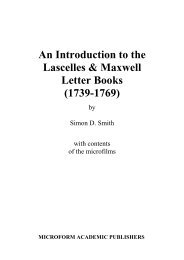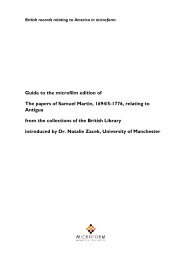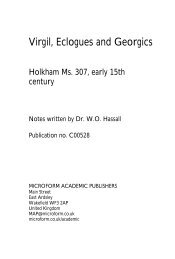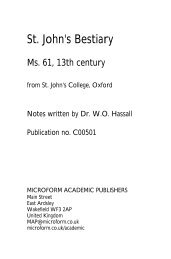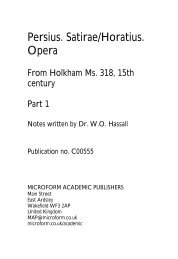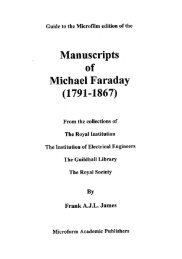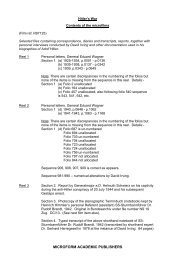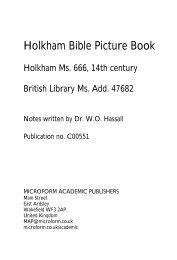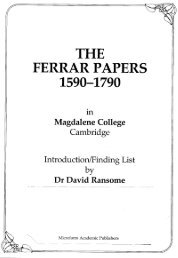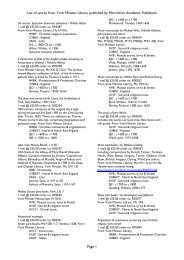An introduction to the plantation journals of the Prospect ... - Microform
An introduction to the plantation journals of the Prospect ... - Microform
An introduction to the plantation journals of the Prospect ... - Microform
Create successful ePaper yourself
Turn your PDF publications into a flip-book with our unique Google optimized e-Paper software.
<strong>An</strong> Introduction <strong>to</strong> <strong>the</strong> Plantation Journals <strong>of</strong><br />
<strong>Prospect</strong> Sugar Estate, Jamaica<br />
<strong>Prospect</strong> is <strong>the</strong> name <strong>of</strong> a sugar estate that once operated in <strong>the</strong> parish <strong>of</strong><br />
Portland in <strong>the</strong> north-eastern corner <strong>of</strong> Jamaica. 1 For five decades prior <strong>to</strong> <strong>the</strong><br />
abolition <strong>of</strong> slavery in 1834, this <strong>plantation</strong> was <strong>the</strong> home and workplace <strong>of</strong> a<br />
population numbering up <strong>to</strong> 162 enslaved men, women, and children. 2 Approximately<br />
half <strong>of</strong> <strong>Prospect</strong>’s inhabitants were born in<strong>to</strong> slavery, most <strong>of</strong> <strong>the</strong>m on <strong>the</strong> property<br />
itself; <strong>the</strong> o<strong>the</strong>rs were forcibly shipped <strong>to</strong> Jamaica from Africa in order <strong>to</strong> replenish a<br />
labour system unable <strong>to</strong> reproduce itself naturally. Condemned <strong>to</strong> a lifetime <strong>of</strong> <strong>to</strong>il,<br />
<strong>the</strong> majority <strong>of</strong> <strong>the</strong> enslaved worked in <strong>the</strong> cane fields, boiling house, and crushing<br />
mill <strong>to</strong> produce rum and sugar for <strong>the</strong> benefit <strong>of</strong> absentee owners in Britain.<br />
Much remains <strong>to</strong> be discovered about <strong>the</strong> inhabitants <strong>of</strong> this previously<br />
unstudied sugar estate. This <strong>introduction</strong> is based on a general survey <strong>of</strong> a batch <strong>of</strong><br />
manuscripts preserved in <strong>the</strong> Barclays Group Archive, Manchester. 3 The collection<br />
primarily consists <strong>of</strong> eight volumes describing <strong>the</strong> daily operation <strong>of</strong> <strong>the</strong> <strong>plantation</strong><br />
between 1784 and 1793. 4 Some insights in<strong>to</strong> <strong>the</strong> later his<strong>to</strong>ry <strong>of</strong> <strong>Prospect</strong> (from 1817<br />
until 1834) have also been gleaned from <strong>the</strong> slave registration and compensation<br />
commission records preserved in <strong>the</strong> National Archives in London. 5<br />
Provenance is <strong>the</strong> first issue that must be addressed when encountering a<br />
new documentary hoard. The precise circumstances under which <strong>the</strong> manuscripts<br />
came in<strong>to</strong> <strong>the</strong> possession <strong>of</strong> Barclays are not known, but it is clear that <strong>the</strong> Bank has<br />
provided <strong>the</strong> materials with a resting place for a great many years. In Mat<strong>the</strong>ws and<br />
Tuke’s 1926 his<strong>to</strong>ry <strong>of</strong> Barclays, <strong>the</strong> documents are mentioned briefly:<br />
It must not be inferred from this catalogue <strong>of</strong> famous names that <strong>the</strong> Bank did<br />
business only with people at one end <strong>of</strong> <strong>the</strong> social scale; <strong>the</strong> majority were not<br />
notable, like many who have been mentioned, nor even no<strong>to</strong>rious, like poor<br />
Comte d’Orsay; but one at least has left behind him some interesting books and<br />
papers. This gentleman, who was one <strong>of</strong> <strong>the</strong> earliest cus<strong>to</strong>mers, was <strong>the</strong> owner<br />
<strong>of</strong> a <strong>plantation</strong>, and as such was an employer <strong>of</strong> slave labour. Amongst his<br />
papers is his s<strong>to</strong>ck book, <strong>the</strong> first page <strong>of</strong> which contains an account <strong>of</strong> <strong>the</strong><br />
slaves for <strong>the</strong> year 1784. The fact that <strong>the</strong> succeeding pages deal in a similar<br />
way with horses, cattle and implements shows that <strong>the</strong> slaves were looked upon<br />
merely as part <strong>of</strong> <strong>the</strong> lives<strong>to</strong>ck on <strong>the</strong> property. 6<br />
Mat<strong>the</strong>ws and Tuke discreetly omitted <strong>to</strong> name <strong>the</strong> owner <strong>of</strong> <strong>Prospect</strong> Estate,<br />
referring <strong>to</strong> him only as a ‘gentleman’, but <strong>the</strong>y did suggest a route by which <strong>the</strong><br />
papers were acquired by <strong>the</strong> Bank; namely, as part <strong>of</strong> a miscellaneous deposit by<br />
one <strong>of</strong> its earliest cus<strong>to</strong>mers. The owner <strong>of</strong> <strong>Prospect</strong> can now be revealed as <strong>the</strong><br />
London and Kings<strong>to</strong>n merchant, Stephen Attlay, who in an account current <strong>of</strong> 1785-6<br />
was accorded <strong>the</strong> title <strong>of</strong> ‘Esquire’. Over <strong>the</strong> years, many strange items have been<br />
left in safe deposit boxes across <strong>the</strong> world by banking clients who, for a variety <strong>of</strong><br />
reasons, have never returned <strong>to</strong> claim <strong>the</strong>m. Do <strong>the</strong> <strong>Prospect</strong> papers fall in<strong>to</strong> <strong>the</strong><br />
category <strong>of</strong> misplaced personal effects?<br />
1



